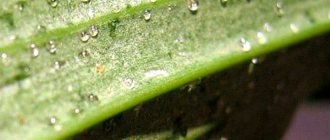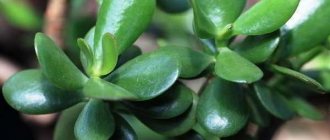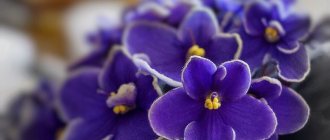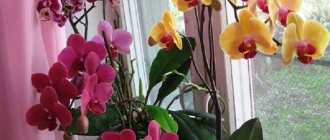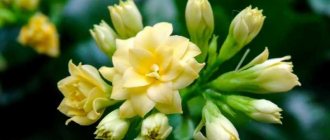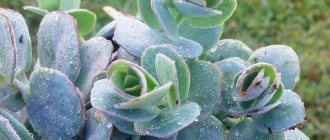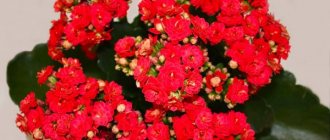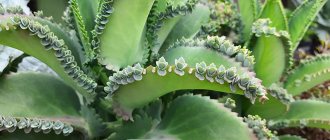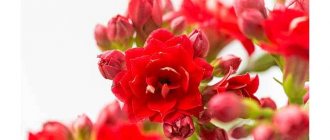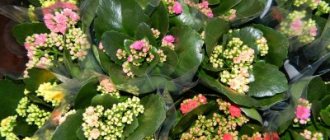Temperature
Kalanchoe grows well at temperatures of 18-22ºС. And if the flower tolerates a slight decrease in temperature without harm, then an increase in temperature negatively affects the appearance of the plant.
If the air temperature stays around 30ºC for a long time, the leaves of the plant begin to turn yellow and fall off. First, the oldest lower leaves of Kalanchoe dry out and fall off, but if cool weather does not set in, the young leaf blades also begin to yellow.
Kalanchoe grows best in air-conditioned rooms , where even in the summer heat the air temperature can be easily regulated. If there is no air conditioning in the room, in summer the flower is kept on the north-eastern windowsills, where it is not hot and the sun only appears in the morning.
Incorrect lighting
Kalanchoe requires bright lighting. It requires direct sunlight for 2-3 hours a day. Without this, the stems will begin to stretch and the leaves will shrink.
Why do Kalanchoe leaves dry out?
Do not leave the plant in direct sunlight all day.
In this case, yellow spots form on the leaves of Kalanchoe - sunburn.
The burned leaves of Kalanchoe turn yellow and the leaves dry out and then fall off.
To keep the plant green and beautiful, it is kept on eastern windows, where the sun appears only for a few hours. The rest of the time, the flower here is in diffused light, which has a beneficial effect on its growth.
Watering errors
Sometimes yellowness on Kalanchoe leaves occurs due to improper soil moisture. Despite the fact that Kalanchoe is a succulent, it requires regular watering. However, too wet soil is detrimental to the plant. It is harmed by both drying out of the soil and stagnation of water in it.
If the plant regularly does not receive the required amount of moisture and the earthen ball in the pot dries out completely, the lower leaves begin to turn yellow, dry out and fall off.
If the plant is watered too often and intensely or the drainage in the pot does not allow excess moisture to drain out, water may stagnate in the soil. This leads to rotting of the root system.
The flower stops growing, then its leaves begin to turn yellow and fall off en masse.
The optimal watering regime will ensure the health of the plant , its intensive growth and decorative effect. With proper watering, the soil in the Kalanchoe pot should be slightly moist. Between waterings, only the top layer should dry out.
Very low air humidity
Kalanchoe is adapted to exist in low humidity. However, very dry air can greatly harm the plant. This is especially dangerous in combination with high temperature conditions. Under such conditions, the leaves turn yellow and dry out, and then fall off.
Most often, plants suffer from dry air during the heating season . With proper maintenance in winter, the air temperature for Kalanchoe should be reduced to 15-17ºС.
But if this is not possible and the plant is kept at room temperature, and even near a heating radiator, it may lose most of its leaves, especially from the side of the heating device. To prevent this from happening, in winter you need to keep the flower on the coldest windowsill, away from heating.
Successful cultivation of Kalanchoe, prevention of diseases and pests
Kalanchoe can be successfully grown at home if you follow simple rules. Lush flowering and plant health depend on proper care and care. Drafts, sudden temperature changes, excessive moisture and heat, and dry air are not allowed. All these factors weaken Kalanchoe, and the plant is more often susceptible to illness.
Did you know? Kalanchoe is one of the few plants that can purify indoor air from germs, influenza viruses and other harmful microorganisms.
Basic plant care is as follows:
- Water the flower correctly. The tropical plant is very delicate, and too much water can cause the roots to rot. Water Kalanchoe in small doses, especially when flowering begins. The plant stores enough liquid, so you don’t need a lot of additional water.
- Control the lighting. The flower loves the sun, and you can safely leave the Kalanchoe to bask in the sun until noon. However, after lunch, the plant should be moved into the shade or covered with a light cloth. In winter, Kalanchoe does not need to be moved, since the sun is not so active.
Important! The plant should not be kept in a room with high temperatures. Under such conditions, Kalanchoe leaves curl
Another extreme is the temperature being too low. To avoid damage and hypothermia, move the plant away from drafts and radiators.
Kalanchoe - a gentle and cheerful exotic plant
With your care and constant attention, the flower will delight you with its beauty and beneficial healing properties for a long time.
Feeding errors
Why do Kalanchoe leaves fall off? Often in Kalanchoe, when there is a lack of nutrition, the lower leaves begin to turn yellow and then fall off. It is necessary to feed the plant, because it is planted in soil for succulents, which is usually not rich in humus.
During the growing season, soil depletion soon occurs. And regular but moderate feeding will provide the flower with a decorative appearance and green foliage.
This plant should be fed very carefully. Any excess of nutrients in the soil is just as harmful to the flower as their deficiency.
Fertilizing is carried out only from May to September . In other months, Kalanchoe is not fertilized.
Kalanchoe is fed 1-2 times a month with liquid fertilizers for succulents. They need to be diluted so that their concentration in water for irrigation is 2 times lower than indicated on the package.
Pests
Kalanchoe is often grown at home and is rarely attacked by pests. But if care is improper, the plant can become a reservoir for harmful insects.
The parasites of this flower are the following insects:
Let's look at each pest in more detail.
Aphids are the most dangerous enemy for Kalanchoe. Aphids are small greenish-black sucking insects. It initially lives on the underside of the leaf and eventually spreads throughout the plant. In the presence of such a pest, the leaves begin to lighten and become sticky to the touch. This is the result of the action of aphids, which secrete a toxic substance. In this case, Kalanchoe does not bloom, and the buds that appear wither and fall off.
The danger of infecting flowers with this particular insect is that the aphid becomes a carrier of many viruses and creates optimal conditions for the development of the fungus. The fight against it involves destruction by burning the affected stems and leaves, as well as treating healthy parts with an insecticide. It will not be possible to destroy aphids in one go. A minimum of 4 treatments are required at one week intervals.
Late timing and errors in pruning and replanting
Young bushes need to be replanted annually.
Adult Kalanchoe is transplanted into fresh soil every 2-3 years. If replanting is not done or done very rarely, the soil in the pot is greatly depleted and the plant lacks nutrients. Even regular feeding does not help. The lower leaves on the branches turn yellow and crumble, the shoots become bare. Particular attention should be paid to pruning the plant. Only a properly formed bush will delight you with beautiful, large and green leaves.
If the plant is not pruned, the old leaves will gradually turn yellow and fall off. This is a natural process, but if the shoots are not rejuvenated by pruning, they become very elongated and unattractively exposed.
How to revive Kalanchoe?
If your pet is severely damaged and in this form is no longer pleasing to the eye, it is necessary to restore it. There are several ways:
Rooting the tips of the shoots. The crown of the shoot is cut off with a sharp knife, the cut is treated with a solution of the drug “Kornevin” and placed in damp, crushed sphagnum or sand.- Topping. An adult Kalanchoe often stops blooming and becomes inconspicuous. In this case, you need to remove the shoots that had flowers.
After the young shoots begin to grow, pinch out 2 leaves on them. Removing the tops also helps stimulate the formation of young growth. If the shoots below are bare but look normal on top, cut off the bare top and root it. You can put the crown in water, or you can immediately plant it in fresh soil and water it abundantly.
The plant will look limp at first, but when roots form on it, it will regain its elasticity and begin to develop. Once this happens, reduce watering.
Choose the optimal place for its existence, follow the care recommendations, avoid damage by insects, and it will thank you with long and very decorative flowering.
If you find an error, please select a piece of text and press Ctrl+Enter.
Why do Kalanchoe leaves wither?
Quite often, flower growers are faced with the following problem: Kalanchoe leaves become soft, wither and soon fall off. There are several reasons for leaf wilting:
- Lack of moisture in the soil;
- Root system rotting;
- A sharp drop in temperature.
Young plants that have not yet accumulated enough water in the above-ground part may drop their leaves when the soil dries out.
The leaf blades become soft, but after watering they are completely restored. It is important to prevent the soil from drying out.
If you still forgot to water the plant, drying out should not be long, otherwise the flower will shed its leaves.
When water stagnates in a pot, root rot occurs - a fungal disease . It manifests itself in the withering and falling of the leaves of the plant. Unfortunately, in this case the plant cannot be saved. To prevent root rot, you must strictly adhere to the watering regime.
Causes of blackening of Kalanchoe leaves
Why do the leaves of Kalanchoe turn black - it was struck by a fungal infection.
Often the flower suffers from leaf or stem rot, which occurs when there is excess moisture. Increased humidity and stagnation of air in the room contribute to this. Therefore, you need to keep Kalanchoe in a regularly ventilated area. Often fungus occurs due to improper watering. Even if watering is moderate, but water regularly gets on the leaves and shoots of the plant, there is a high risk of infection with rot.
Therefore, it is necessary to water carefully, making sure that the water gets only into the soil and does not wet the ground part of the bush.
Basic succulent diseases and home therapy
Kalanchoe, like any plant, is susceptible to various diseases
It is important to identify the disease in time and begin treatment so that the flower does not die
Late blight
The disease actively affects garden and vegetable plants, but indoor flowers are also not immune to this problem. It is characterized by the appearance of brown spots on the leaves, which gradually turn black. After some time, the disease spreads throughout all the branches and stem, they become soft and rot.
Note! Late blight very quickly affects the entire flower. If the root system of Kalanchoe is diseased, you can easily remove it from the pot.
Late blight is caused by improper and irregular watering, stagnation of moisture in the pot, and unsuitable and too dense soil. Often such a disease is caused by irrigation with rainwater.
It is possible to cope with the disease. To do this, remove all affected leaves and treat the sections with activated carbon. It is best to transplant the plant into a new pot, after irrigating it with a solution of potassium permanganate (1.5 g per 5 liters of water). Specific antifungal agents will help well.
Powdery mildew on Kalanchoe
Powdery mildew often appears on flowers located next to each other in a warm and humid room. A coating on the leaves is noticeable on Kalanchoe. When the temperature drops, the fungus will die, but the plant will not be cured. The leaves will gradually curl and fall off, and the succulent will bloom poorly and little.
For your information! Infection often occurs from one flower to another with the help of water and wind
Therefore, care must be taken when spraying plants.
Many people are interested in what to do if there is a white coating on the leaves of Kalanchoe. Treatment consists of complete control of watering; irrigation is carried out only at the root; moisture should not fall on the leaf blades and stem. The pot is moved to another place, providing the Kalanchoe with more air and space. Be sure to treat with specific fungicides to kill the fungus.
Powdery mildew on succulents occurs due to waterlogging
Stem rot
The cause of this disease is a sharp drop in air temperature. When affected, the plant experiences blackening of the stem and leaves, softness and rotting of all parts.
The main treatment is to create optimal conditions for growth and development for Kalanchoe. The normal temperature for a flower is 15-20 °C in winter.
It is worth remembering that at low temperatures there should be no frequent watering to avoid rotting of the root system.
Gray rot
A similar disease affects indoor flowers quite often. The fungus quickly spreads to all parts of the plant. The presence of white dust located in small piles is noticeable on the leaves. There are brown water spots on the stem. All parts of the plant located above the site of damage die off.
Gray rot often appears due to irregular and improper watering. Constant stagnation of moisture provokes the development of the disease. It is imperative to remove fallen leaves from the pot to prevent fungal diseases.
Treatment is carried out with special fungicidal preparations, treating the plant twice with a break of 2 weeks. Solutions are prepared according to instructions.
Gray rot can destroy a flower in a matter of days
Ring spot
The disease is manifested by the formation of small spots on leaf blades. At the first stage they are yellowed, gradually turning brown. The disease takes a very long time to develop. At first the spots are small, but gradually they merge into one large one. Leaves may turn yellow, dry out and fall off.
Important! Ring spot is caused by a fungus. It is recommended to carefully control the watering of Kalanchoe, pour water only at the root and make sure that it does not stagnate.
It is recommended to treat with special preparations; the pot is moved to a more spacious place.
In most cases, Kalanchoe diseases are caused by fungi that love high humidity.
Therefore, it is important to irrigate the flower regularly, but make sure that there is no excess moisture.
Why do Kalanchoe leaves dry and wither?
But, despite the simplicity of caring for Kalanchoe, some problems with the flower may still arise. Many people wonder why the leaves turn yellow and dry, wither or curl and other similar questions. The reasons for this may lie in the natural processes of the plant’s life cycle or improper care or replanting, plant diseases, pests, insufficient nutrients in the soil, or vice versa. Why Kalanchoe dries - this is what we will talk about in this article.
One of the most common problems faced by housewives of all types of Kalanchoe is the yellowing leaves of the flower. Leaves may turn yellow in different parts of the plant, which indicates different reasons for this process.
If the leaves turn yellow only on top, but remain green below and fall off, then the problem is not enough light. If the leaves begin to turn yellow evenly along the entire length of the stem, then most likely, on the contrary, the flower is receiving too much direct sunlight and should be moved to partial shade.
If the lower leaves turn yellow and dry out, this may indicate that the soil is drying out. Also, the lower leaves may fall off due to too dry warm air. This process occurs especially often in winter due to dry air. Then the flower pot should be removed away from the central heating radiators. The ideal air temperature for Kalanchoe during the winter dormant period is 13-15 degrees. In the summer, due to extreme heat, its leaves may turn red, so at this time all pots with plants should be removed from areas of direct sun exposure to partial shade.
Also, the plant can stretch in length and shed its lower leaves for the following reasons:
- lack of lighting;
- excessive moisture;
- aging of a flower as a natural process.
If the plant is more than a year old, it may need rejuvenation. This procedure is carried out in the spring.
How to solve the problem of stem stretching? In fact, it’s easier to renew a flower by transplanting its stems into a new pot and then taking care of it more carefully so that it retains its freshness and lushness longer. What you need to do for this:
- trim leaves with children so that they do not take part of the energy and nutrients;
- periodically pinch off the top leaves so that the Kalanchoe grows not only upward, but also in width;
- in summer or spring at the end of the season, you can carry out the procedure of pinching the tops to form side pagons;
- place the flower in a bright place, but so that the direct rays of the sun do not fall on it;
- in winter, move the pot to a south window and, if possible, give it additional “light” using fluorescent lamps;
The volume of the pot also plays an important role. The lower leaves may fall off simply because the flower is too cramped in the pot.
Also, not only the leaves, but also the stem itself can dry out. In this case, there is a high probability that parasites live in the root system of the flower and absorb all the moisture from the central stem.
You can often see brown tips on the leaves that look like they have dried out or burned. What could be the reasons and how to fix this problem:
- Watering with regular tap water is a common mistake. Chemicals such as fluoride and chlorine found in tap water can cause leaf burns. Any plants should always be watered only with at least water that has been standing for several days.
- Improper watering can also be a fairly common mistake. Kalanchoe is a succulent, so it can be kept for a long time without watering. But you shouldn’t be zealous in this regard. Kalanchoe is watered once a week during the flowering period, and even less often during the dormant period of the flower, 1-2 days after the earthen coma has completely dried out. If the stem or its leaves do not dry, but wither, then the problem is waterlogging. You need to let the earthen clod dry completely and only then do the next watering. To prevent putrefactive processes, the plant can be transplanted into new soil and not watered for several days.
- The flower also practically does not need spraying. If the room is hot, then its leaves can be moistened, but not more than once every day or two.
- The air is too dry. Increasing the amount of watering will not only not cope with this problem, but will further aggravate it, causing root rotting processes. You can solve the problem of dry air in the autumn-winter period by using gravel or an air humidifier. During this time, you can also move the pots to the kitchen or keep several groups of flowers on the same windowsill. And, of course, pots should be kept away from heat sources.
- Over-fertilized soil can also cause leaf tips to dry out due to excess salts. In this case, a white coating appears on the top layer of soil. It needs to be removed and new soil added. The optimal option for feeding Kalanchoe is once a month. For flowering plants it is a complex fertilizer, and for non-flowering plants it is a fertilizer for succulents.
- If the leaves of a plant dry out, curl and fall off in the summer, especially if it grows on a balcony or in the garden, then there is a high probability that it has been infected by aphids. By “bathing” the flower in soap suds, cutting off infected areas and treating with nicotine sulfate, you can get rid of these pests and save the flower from complete death.
- The formation of weeping brown spots may indicate that the flower is damaged by a viral or bacterial infection. In this case, the infected leaves must be removed and the entire flower treated with phytosporin. After this procedure, you should reduce watering for a while and do not spray the leaves.
- If for some reason the Kalanchoe has not been watered for a long time, do not suddenly flood it with water, this will contribute to the formation of rot in the root system. Watering should be gradual and moderate.
Diseases
If improperly cared for at home, Kalanchoe becomes susceptible to various types of diseases. External manifestations of flower disease can be different. If this plant is sick, black spots and even mold may appear on its leaves. At the beginning, the spots will be small, and then they will begin to increase in size. The appearance of spots on the leaves indicates that the Kalanchoe has been infected by a fungus. To get rid of it, it is necessary to completely spray the plant with fungicides.
The main reason for the appearance of fungus and black spots is severe waterlogging of the soil, as well as a violation of its aeration. Therefore, it is not enough to simply spray the flower with fungicides; you also need to transplant the plant into another pot with new soil.
In addition, brown spots may appear on the leaf blade. Their appearance indicates the presence of a disease called Dropsy. It develops with a combination of waterlogging and temperature changes. To get rid of this disease, you need to move the pot to a drier and warmer place, and also reduce the number of waterings. Sometimes you can notice a white coating on the plant. This means that watering was carried out with too hard water with a high content of lime and salts.
Kalanchoe, in addition to the conditions described above, can also be subject to the following diseases:
- late blight rot. When it occurs, brown spots form on the leaves. The reason for the appearance is poor ventilation, temperature changes between the soil and air, or excessive watering. To combat the pathogen, you need to eliminate negative influencing factors and treat the flower with fungicides;
- gray rot. As this disease develops, weeping spots appear on the stems and leaves, which are always covered with a gray coating. The main reasons for the appearance are excess moisture, insufficient light conditions and poor ventilation. The means of control are the same as for late blight rot;
- powdery mildew. This disease manifests itself in the form of white spots with a powdery coating. Outwardly, they resemble mold. As a result of this disease, leaves fall from the stems. The causes of the disease are considered to be high air temperature and low humidity.
As you can see, improper care of the “house doctor” can lead to its infection with fungal microorganisms and treatment will be required to avoid death.
Why do the leaves and flowers of Kalanchoe bloom dry?
Many species of Kalanchoe have a long flowering period. Its bushes are strewn with bright small flowers, which cannot but cause joy and admiration. If you notice that the leaves of a flowering plant have begun to dry out and fall off, which is not a natural process during this period, then some problems have arisen that have led to similar consequences.
In summer, the flower must be watered several times a week immediately after the earthen ball has completely dried out. Avoid overfilling. Since it may seem that during the period of vigorous flowering the plant lacks moisture, but this is absolutely not the case. Kalanchoe still has enough internal reserves found in its leaves. You should adhere to a watering schedule of 2 times a week.
If the watering was incorrect or excessive, then you should not reduce the amount of water applied too sharply or stop it altogether, this risks the fact that the flower may begin to shed its flowers and leaves ahead of time. It is better to avoid new stress and reduce watering gradually.
Also, the leaves of the plant may begin to dry out and fall off after a period of abundant flowering. In this case, the flower needs to replace the soil or feed it. After flowering, the plant needs radical pruning. The peduncle is removed, as well as all those branches that look weak. It is better to cut the peduncle as low as possible to avoid rotting.
As mentioned above, Kalanchoe is an unpretentious indoor plant that needs a small amount of moisture and light control. It is enough to care for this flower for a few minutes once or twice a week, for which it will reward you with its beautiful lush appearance. As practice shows, the main cause of the problem of yellowing and drying leaves is improper watering, in particular excess moisture (since it tolerates dryness better than waterlogging). And by adjusting the regularity of watering, you can avoid this problem. In addition, dropping leaves is not always an error in care or a disease of the plant; it can be a natural process of aging of the flower.
How to revive Kalanchoe: saving the flower from drying out and rotting
Kalanchoe is considered one of the most unpretentious indoor plants, but due to certain circumstances, even it is not immune from troubles.
Diseases or errors in care can significantly spoil the appearance of a flower and even destroy it. Today we want to tell you how to reanimate a Kalanchoe depending on what happened to it. So, most often the following problems arise with a beautiful blooming flower:
- the foliage dries and falls off;
- leaves wither and lose turgor.
Kalanchoe - leaves dry, turn yellow, fall off. Why? What to do?
Why do Kalanchoe leaves curl? Why do Kalanchoe leaves turn yellow, dry out and fall off? The problem lies in the conditions under which the plant is kept. In addition, Kalanchoe can be affected by pests such as powdery mildew, spider mites, and scale insects. Rot is often found on the roots of Kalanchoe. So, how to recognize Kalanchoe diseases and treat them effectively? What to do if there is a white coating and brown spots on the leaves of Kalanchoe? What do the soft leaves of Kalanchoe say? Recommendations from experts, photos of diseases and effective treatment of plants.
Symptoms and causes
Based on the symptoms, you can determine what kind of disease has affected the flower. The signs are usually bright, it is difficult to confuse the disease if the symptoms are pronounced. When looking for the cause of diseases, refer to the following list.
- Brown spots. This is late blight. This disease affects the flower with improperly organized ventilation; the disease can also be caused by excess moisture in the soil. At the beginning of the disease, brown spots appear on the leaves, and gradually the leaves of the Kalanchoe bend upward.
- White plaque. This sign most likely indicates powdery mildew. This, unfortunately, is a common diagnosis for Kalanchoe; a fungal disease most often occurs due to too humid air in the room. At first it resembles a layer of dust, and if the gardener does not examine the Kalanchoe well, he may not attach any importance to the coating. But over time, the “dust” begins to look like flour. Because of this disease, the plant sheds its leaves and withers.
- Gray rot. If the leaves curl and rot and the plant becomes soft, then it is gray rot. This leads to mold growing on the leaves. This kind of rot is precisely gray in color, which explains the name.
- Stem rot. When Kalanchoe trunks dry out and darken, this is stem rot. First, a small black dot appears on the trunk, then it grows to such a size that the entire trunk turns black. This happens when the temperature drops sharply. If just such a phenomenon occurs in winter, the plant is in danger of death.
- Round small spots. This is probably ring spotting. And this, unfortunately, is a death sentence for the plant. It dries up and dies, so don’t wait until it completely wilts; get rid of the diseased flower as quickly as possible.
But not only diseases attack Kalanchoe. The leaves turn yellow and curl due to attack by pests. If the tops of the plant are covered with black mold, and waxy discharge appears on the leaves and stem, it is a mealybug. If the flower has almost dried out in a short time, and its leaves are constantly curling, it is probably a scale insect. The leaves turn yellow from the mite, and if the Kalanchoe first turns yellow and then drops its leaves, it is probably necessary to fight it.
Why do Kalanchoe leaves turn yellow, dry and wither?
Pathologies can be easily detected by the appearance of the culture. With the development of diseases in Kalanchoe, the leaves may turn yellow, dry out, wither or fall off. Sometimes the plant loses its ability to bloom.
A healthy flower has excellent decorative properties
These symptoms require timely initiation of treatment. Otherwise, the Kalanchoe may dry out completely.
Violation of containment conditions
Why do Kalanchoe leaves turn yellow? Most often, the cause of problems is a violation of the rules of crop care.
To identify provoking factors, you should pay attention to the following symptoms:
Yellowing of the foliage, drying of the tips and rapid growth of the crop indicate a lack of light. In this case, it is recommended to move the container with the flower to a brighter place.
However, it is important to ensure that the pot does not stand on the windowsill. Leaves may dry out and fall off due to musty air. In this case, it is recommended to frequently ventilate the room. Dark spots on the foliage are caused by sunburn
The appearance of this sign is the basis for moving the pot to another place. A lack of nutrients can cause the plant's yellow leaves to fall off. Curling of leaves is observed when there is an excess of nitrogen or peat in the soil. In such a situation, it is necessary to move the bush to more suitable soil. Softening and falling leaves occur due to excessive watering or rotting roots. To solve the problem, you need to reduce watering or treat the root system. Dropping of shoots may be due to lack of irrigation. In this case, the plant may even dry out. Regular care of the crop will help to avoid this. Yellowing of leaf blades may be due to excess sunlight.
Important! The appearance of unwanted symptoms may be associated with the development of diseases or pest attacks. To cope with them, you need to carefully treat the culture
Yellowing of the leaves of the crop is associated with improper care
